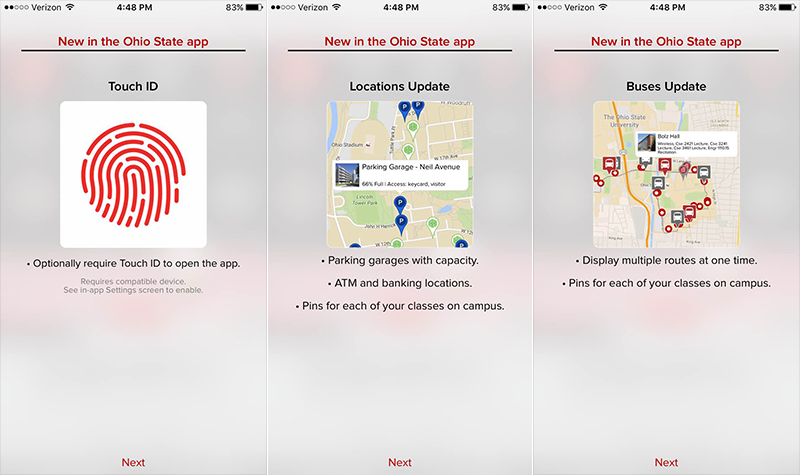
New features of the updated OSU app. Credit: Courtesy of OSU
The Ohio State University app underwent major updates in October, adding several new features aimed to increase convenience around campus.
On Oct. 20, the app received a new map system, which allows users to see multiple bus routes at once, pins on the buildings where they have class, parking garages and their capacity, and bank and ATM locations. And now there is an option that lets users access certain information on the app with their fingerprint.
Benjamin Hancock, the associate director of web and mobile for the Office of the Chief Information Officer, said that this is probably the largest group of updates the app has ever had.
“It allows you to do it all in one place,” Hancock said. “Certain locations are labeled on the map now whereas before you kind of had to dig for them.”
Hancock said that he and his co-workers in the OCIO focus on delivering utility to the students.
“At the beginning of the year, we probably have 80-90 percent of the student base using the app because everybody’s trying to find out where they’re going,” Hancock said. “We look at how we can get information to them because we want to provide things that students are going to use.”
When a user opens the app for the first time after updating, a landing page appears to inform them of what has been changed. This page displays what the new updates are and where to find them.
Hancock said that the app’s usage keeps increasing each year, but he also said that it might just be because of the increasing number of students with smartphones.
App usage has increased approximately 10 percent since this time last year, and the amount of users on the first day of classes has grown from about 28,000 in 2013 to almost 40,000 in 2015, according to OCIO data provided by Hancock. Usage of the OSU athletics section on the app nearly doubled after it was updated to include more features like scores and schedules on Aug. 6.
Heather Olson, a second-year in neuroscience, said she is already benefiting from recent updates to the app.
“I use the CABS buses almost every day,” Olson said. “Sometimes I need to switch routes at a certain stop, so seeing both of my routes at the same time helps me plan my trips easily.”
Olson also said she noticed that the app wasn’t crashing as often as before the updates.
“We average about 99.5 percent crash-free or so and if we get below that, we get concerned,” Hancock said. “Usually before that happens, we get feedback about it though.”
Hancock said the goals are to serve all of their users, be reliable and available when they are needed and make sure there is nothing being under-utilized on the app.
“The driver is feedback. We take all that stuff very seriously,” Hancock said. “Our lead developer, Chris Fish, reads every feedback message we get and if there’s a dot number, he responds.”
There are more plans in the works for the next set of updates, according to Hancock.
“Hopefully early next year, you’ll be able to see all of the dining locations on campus and be able to filter based on what your dietary preferences are,” Hancock said. “If you’re vegan, vegetarian or anything like that, it’ll make your life a lot easier.”
Hancock said that his office is looking for ways to keep students using the app throughout the semester, rather than just at the beginning and end when students are using the app to check their grades.
“We’re trying to identify what’s going to keep students engaged,” Hancock said. “Carmen attachments, schedules and grades are things we know students use every day.”
Hancock also said that within the next couple weeks, students will be able to view their class schedules with Apple Watch.

